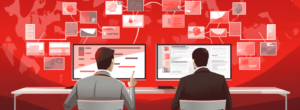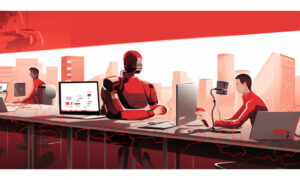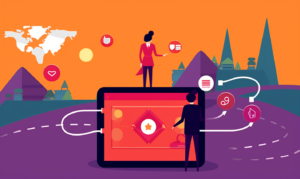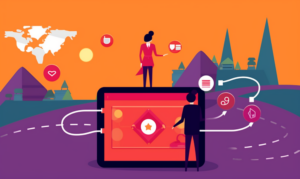Devising a strategy for upskilling in a digital world
- 7 Min Read
With working from home now the norm and innovative technology widespread, employees are discovering they can take advantage of upskilling to remain competitive. How can HR leaders institute strategies to gain the maximum benefit?
- Author: Fin Murphy
- Date published: Aug 20, 2020
- Categories

Recent months, characterized by mass disruption wrought by the Coronavirus pandemic, have highlighted the importance of upskilling to businesses and employees. For the former, to recover lost momentum, compete effectively, and motivate employees, senior leaders are aware of the need to offer comprehensive learning and development opportunities. It’s a pressure felt across industries; according to PWC’s 23rd Annual Global CEO Survey, an astonishing 74% of CEOs who responded were concerned at a lack of availability of the right skills. Similarly, as noted in Deloitte’s 2020 Global Human Capital Trends, over the next three years, 53% of respondents stated that between half and all of their workforce would need to revise their skills and capabilities.
Apart from Coronavirus’ devastating impact on the job market, today’s employees face a range of other challenges: the rise of digital-native generations, fragmenting job security as seen in the gig economy, plus the rise of innovative technology. From Deloitte’s COVID-19: The Upskilling Imperative report, a whopping 37% of UK jobs, 47% of US jobs, and 77% of Chinese jobs are at risk of displacement via automation. Whether on furlough or working with added pressure, many employees are looking at their skills and experience and are keen to upskill; the tech giant Microsoft expects 25 million people to access its learning materials from mid-2020.
While much of the year has been tumultuous, it’s also offered businesses and employees new opportunities to pursue upskilling with vigor. The widespread adoption of working from home, the ubiquity of computers, the variety of L&D providers available and the time saved commuting means that employees can boost their abilities and employability at a pace that suits them. However, this shift creates new implications for HR leaders; what type of content and format best suits effective upskilling? How can businesses transform their employees into lifelong learners? What friction could there be in accessing upskilling material?
These issues can be tackled effectively through a clear and comprehensive digital strategy for upskilling. To learn more about the key considerations, HRD Connect spoke to Deutsche Bank’s Senior Learning Professional, Donna McGrath, and Simon Tindall, Head of Skills and Innovation at the Open University.
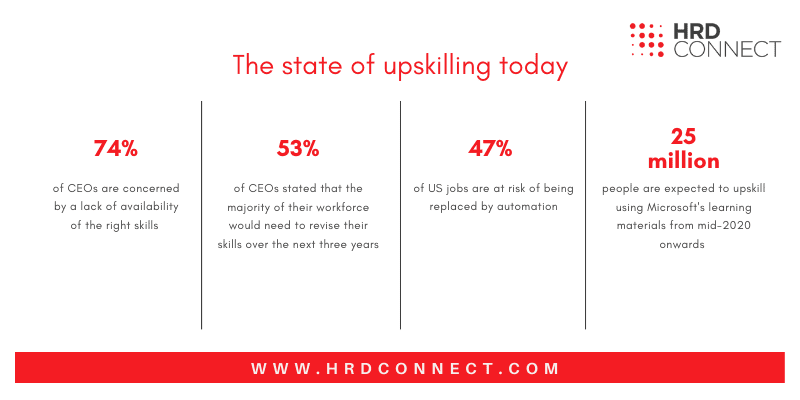
Shaping content to suit employees
The established picture of upskilling centers around day-long face-to-face seminars, workshops, and – with some luck – ice breaker activities. However, the nature of the Coronavirus pandemic has rendered face-to-face opportunities unviable, pushing employees towards remote experience. Tindall explained how this has been following a process of evolution.
He said: “Recent times have seen underlying trends become accelerated; there’s a movement towards more modular, less structured, smaller pieces of education and training. It’s about being adaptable and achieving a level of skills recognition that doesn’t necessarily have to be specific to a particular subject.
For instance, companies like Amazon Web Services want to hire engineers and want them to have an engineering degree, but are not that worried about a particular discipline in engineering. They’re interested in whether they have the flexibility and adaptability to fit within the organization.”
McGrath went on to highlight how the changing nature of content not only meets professional expectations but personal needs.
“Digital allows you to access such a range of content,” she said.
“That has been really interesting. One of my colleagues at Deutsche Bank has been creating some really easy-to-access resources on certain topics. I don’t like videos, for instance, as I’m hard of hearing, so my preference would always be to read something.
“Having a choice is something that the digital way of learning really provides. People have traditionally felt that you don’t always learn in the classroom, so we’ve had a fantastic opportunity to show the different methods available.”
Accounting for business imperatives
A key issue with so many HR strategies of the past was that they didn’t factor in the possibility of a pandemic, leaving many businesses caught short. However, the concerns over coronavirus’ lingering impact and the possibility of a second wave could potentially excessively influence strategizing to a business’ detriment.
Tindall argued that recent times have forced employers to ask bigger questions about their approach to upskilling.
He said: “Increasingly, over the next six to twelve months, maybe the next two to three years, employers will have to change how they train their existing and new staff, which isn’t just moving from face to face to digital. It’s about asking bigger questions – where do we want our workforce to be? Where are the skills gap?
“There’s an increasing desire to relate education and training to employment, but there’s still a huge lack of core skills, fundamental skills that are not necessarily specific to any particular job but are utilized by all jobs. We see a lack of communication skills, networking skills, and linkage skills.”
McGrath also discussed the competing demands with businesses, how technology can help and in what ways it can be implemented successfully.
She said: “In any organization, you’ll always have different groups that will have specific requirements and are looking at developing different processes and approaches, which can sometimes build friction. Technology can help to really bring different groups together because you get a much better experience, but you’re also able to share more easily.
“You can create social learning groups and see what’s happening across different areas, plus hopefully breaking down what seems like ring-fencing around parts of the organization, but it’s a massive challenge. It’s not just about implementing a new platform, but about how people can engage with it and see the advantages, understanding what people are doing and the challenges they have.”
Combining the best of technology and the human touch
In a world increasingly transformed by innovations like data analytics, AI, and augmented reality, HR leaders want to strike the right balance between people and technology, enabling businesses and employees to experience the best aspects of both. Tindall noted how technology is set to create further disruption but will be vital to employees to show off their upskilling in the future.
He said:”The introduction of AI will have a huge impact on people’s careers. I can see an emerging trend around digital badging, where people can pick up badges or electronic awards that recognize a piece of learning. That doesn’t necessarily mean doing a course, but maybe completing a project or attending a conference, which adds to a portfolio of what you’ve accomplished.
“When you put on your CV ‘I’m a good negotiator,’ you can have proof of that, not just that you’ve completed a degree. There’s a growing interest in lived experience as much as traditional academic education.”
McGrath detailed how upskilling materials can be tailored for individuals through the easy accessibility of digital platforms.
She said: “The last few months have been a really nice opportunity to think about how to make the best of digital resources, and how to market them so people can find them more easily.
“It’s really about being able to help people access learning that can be personalized for them, a much easier journey for the learner to find the content that’s relevant, that could be matched to the skills that they’re interested in developing. It’s about getting away from sifting through a myriad of stuff that can make you feel overwhelmed by the amount of content that’s on there.
“One of the big things has been that if you’re going to do more virtual collaboration, how do you make that work, and how do you ensure that everyone can have a voice and contribute, which has just been a fascinating challenge. We’re a global team and we have to work out how we can interact more effectively.”


